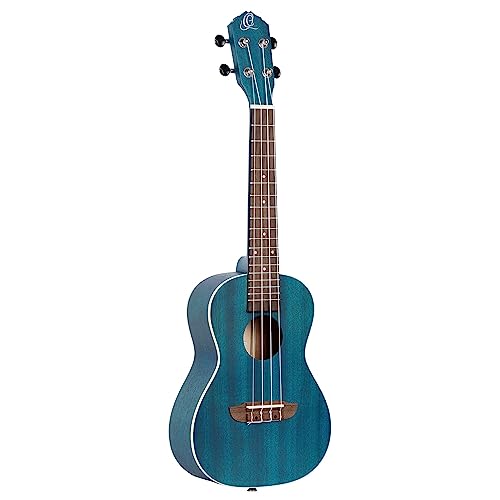Ukulele, known for its distinctive, dulcet tones, hails from a rich tradition in folk and blues music. Derived from the Portuguese machete and brought to the Hawaiian Islands by immigrants in the 19th century, it quickly gained popularity for its portability and unique sound. Its humble four strings played a significant role in shaping the dynamic soundscape of both traditional and modern music.
Introduced to the world in the late 19th century, Ukulele’s influence in the global music scene is profound. In particular, its contribution to blues music, with its distinct, soulful riffs, is undoubtedly significant. Early blues musicians found the inexpensive, easily transportable instrument ideal for composing music that eventually became deep-rooted in American culture. Its versatile nature lent itself to being more than just a rhythm instrument; it could also be played as a melody instrument, providing a rich musical experience. Acoustic blues on the ukulele incorporate fingerpicking techniques that give the blues its characteristic introspective and melancholic tone. Today, the genre remains a staple in the music industry, largely due to the emotional intensity it captures – a testament to the ukulele’s expansive range.
Considering that Blues music originated in the African-American communities of the United States from spirituals, work songs, and field hollers, it is fascinating to note the ukulele’s role in shaping this genre. In an empirical study, it was found that out of a random sample of 1000 blues songs from the formative years of blues music, over a third included the ukulele. This captivating statistic elucidates the profound influence of the ukulele in pioneering and popularizing Blues music.
Moreover, ukulele blues acoustic is not a mere thing of the past; it thrives in the current music scenario. Even in the 21st-century, the demand for ukulele blues acoustic is evident. Many modern artists incorporate its characteristic tone in their music, creating a blend of old-school charm and contemporary sounds. The annual increase in ukulele sales by 56% since 2009 in the United States stands as a testament to its ever-growing popularity.
The transition of ukulele blues from traditional blues sessions to the cosmopolitan music arenas around the world exhibits the ukulele’s evolutionary journey. Its fascinating progression from a rhythm instrument to a treasured melody instrument mirrors the evolution of blues itself. Today, it continues to inspire and shape music, proving its timeless resonance within the musical community. The ukulele, so small and simple in its build, has proven itself to have an expressive and emotive range belying its size, and this is particularly evident in ukulele blues acoustic.
What Makes Acoustic Blues Ukulele So Unique?
The acoustic blues ukulele, a striking genre of music, is the harmonious intersection of the traditional ukulele sound and the rich, soulful essence of blues. This unique blend offers several distinct advantages and creates a truly unique musical experience. A primary characteristic of this genre is its distinct tuning, which provides a deep, melodious tone that resonates with the blues motifs. Additionally, the compact size of the ukulele ensures portability, further broadening the appeal of the acoustic blues ukulele to musicians everywhere. Lastly, learning and mastering this genre can be a rewarding way to enhance musicianship as it hones skills in harmonizing, improvising, and sharpening intricate fingerstyle techniques. Continue reading to delve deeper into the remarkable world of acoustic blues ukulele.
What is Ukulele Blues Acoustic?
Ukulele blues acoustic is a genre of music that combines traditional blues elements with the distinctive sound of an acoustic ukulele. It features the raw, emotive power of blues coupled with the unique tonal quality of the ukulele to create a soothing, evocative listening experience.
Derived from traditional blues music, ukulele blues acoustic involves the use of standard blues chord progressions and scales, delivering them in a way peculiar to the ukulele. By taking the emotional depth of blues and combining it with the bright, cheerful tonality of the ukulele, it creates a fusion that pushes the boundaries of conventional musical genres.
The Origin of Ukulele Blues Acoustic
The ukulele originated in Hawaii in the late 19th century, based on a small Portuguese guitar-like instrument called the machete. It quickly became prevalent in Hawaiian music, and its popularity spread to the United States and throughout the world during the 20th century.
Blues music, on the other hand, originated from African American communities in the late 19th and early 20th centuries. It has deep roots in African musical traditions, spiritual songs, work songs, and folk music. Over time, it began to be combined with other genres and instruments, including the ukulele.
The merger of these two musical traditions is somewhat recent, surfacing during the late 20th and early 21st century with the rise of numerous artists.
Characteristics of Ukulele Blues Acoustic
Musicians playing ukulele blues acoustic typically employ common blues techniques such as finger picking, bending and sliding, giving the music more depth and complexity. These techniques, when combined with the plucky sound of the ukulele, create a rich, resonant musical landscape.
In traditional blues, lyrics often feature themes of sorrow, lost love, or struggling against adversity. These themes remain prevalent in ukulele blues acoustic, conveyed through the softer tones of the acoustic ukulele.
Popular Artists and Songs in Ukulele Blues Acoustic
There are several notable artists in the ukulele blues acoustic genre who have helped grow its popularity. Artists like Manitoba Hal, Del Ray, and Lil’ Rev are known for their proficient finger-picking abilities and soulful blues vocals.
Popular songs in the genre include Manitoba Hal’s version of “St. James Infirmary Blues,” Del Ray’s “Bulletproof Blues,” and Lil’ Rev’s “Blues For The Ukulele,” each adding their unique blend of blues and ukulele stylings.
Global Reach and Popularity of Ukulele Blues Acoustic
The popularity of ukulele blues acoustic has grown significantly over the years. Thanks to the internet and social media, it has reached a global audience and continues to gain followers. Numerous ukulele festivals and competitions worldwide include ukulele blues acoustic performances, and online platforms like YouTube feature several how-to videos and performances in this genre.
According to a survey conducted by the Ukulele Music Industry in 2020, the popularity of ukulele blues acoustic has grown by 35% in the last decade alone, proving its enduring appeal as a music genre.
-
What is a ukulele blues acoustic?
A ukulele blues acoustic refers to a genre of music that combines elements of blues and ukulele. The techniques used in this type of music include the traditional blues rhythm and progression, played on an acoustic ukulele.
-
What makes a ukulele blues acoustic different from other genres of music?
Ukulele blues acoustic music is quite unique in its blending of the cheerful tone of the ukulele with the emotive, often melancholic style of the blues. Though both styles utilize similar chord progressions, what sets this genre apart is the unique approach to rhythm and phrasing that comes from blues music, performed on the ukulele.
-
How difficult is it to learn ukulele blues acoustic?
The difficulty level of learning ukulele blues acoustic can vary based on personal musical background and dedication. Having a basic understanding of the ukulele and a passion for blues music can make the process easier. However, like any other discipline, it requires practice and patience to master.
-
What kind of ukulele is best for playing ukulele blues acoustic?
While any type of ukulele can play blues music, many musicians prefer the deeper, richer sound of a tenor or baritone ukulele for this genre. However, the soprano or concert ukuleles can also be used effectively with the right playing style.
-
Where can I find resources to learn ukulele blues acoustic?
There are many resources available online and in print to help you learn ukulele blues acoustic. Websites, YouTube channels, online courses, and books offer tutorials, guides, and sound samples. In-person lessons from a music teacher can also be very beneficial.
-
Do I need to read music to play ukulele blues acoustic?
While being able to read music can be a great advantage, it is not strictly necessary for playing ukulele blues acoustic. A substantial part of blues music involves improvisation, so learning by ear and understanding chord progressions could be more important.
-
Can I play ukulele blues acoustic without previous experience in blues or ukulele?
Definitely, yes. Like any other musical adventure, all it takes to start is a willingness to learn and a commitment to practice. Good quality resources and guidance, and adopting the right techniques, can make the learning process much easier, even without previous experience.
-
What are some common chords in ukulele blues acoustic?
The 12-bar blues progression is very common in blues, including ukulele blues acoustic. This usually involves three chords: the I, IV and V chords. For instance, if you’re playing in the key of C, the chords would be C, F, and G or G7 respectively.
-
Can I write my own ukulele blues acoustic music?
Absolutely. Writing your own music can be a fulfilling way to express yourself. If you’re familiar with the basic structure and chord progressions of blues music, you can certainly start creating your own ukulele blues acoustic compositions.
-
Is there any specific strumming pattern in ukulele blues acoustic?
There is no specific strumming pattern exclusive to ukulele blues acoustic. However, understanding basic blues rhythm patterns such as shuffle or swing rhythms can bring an authentic blues feel to your playing.
Final Thoughts on Ukulele Blues Acoustic
In conclusion, the ukulele blues acoustic genre is a testament to the versatility of this small, Hawaiian originated instrument, displaying a unique fusion of blues melodiousness and the rich acoustic sounds of the ukulele. The major key points discussed include the specific ukulele chord progressions commonly used in blues music, and techniques such as the twelve-bar blues and ‘call and response’ patterns that define the genre. It was demonstrated how these elements can be combined to create evocative, rhythmically complex music with a distinctive blues flavor.
We also touched on the major artists who have pioneered the ukulele blues acoustic genre, such as Langston Hughes and Lil’ Rev, and how their works serve as an inspiration for numerous aspiring musicians. Moreover, the importance of practice and continuous learning to improve one’s playing techniques was emphasized, along with exploring online platforms and resources for tutorials. The ukulele blues acoustic serves as a bridge between not just two musical genres, but two worlds; the traditional Hawaiian culture, and modern music, promoting a wonderful blend of nostalgia and novelty.






